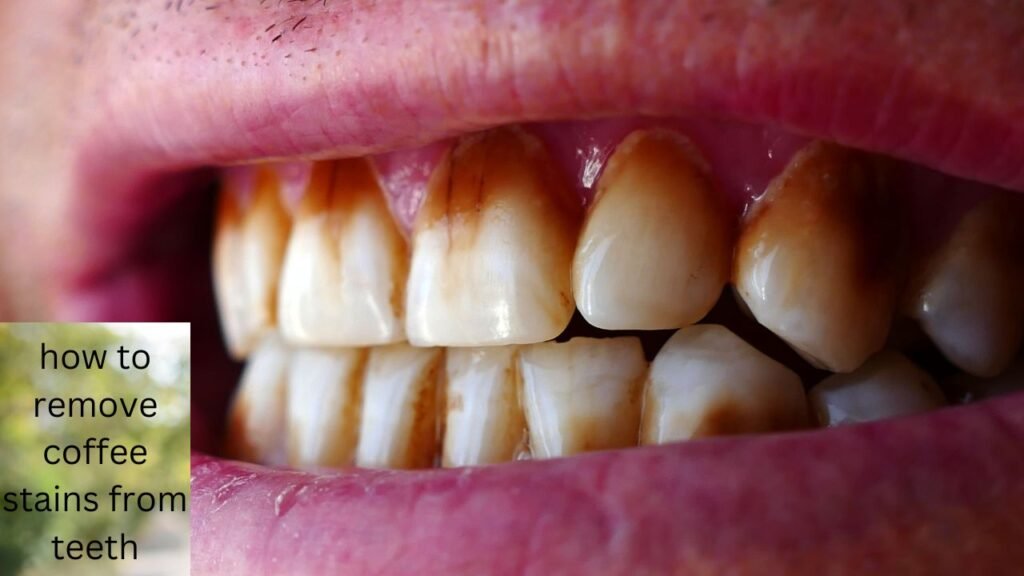Coffee is a staple for millions, offering a morning boost and an afternoon pick-me-up. But while coffee energizes you, it can leave unsightly stains on your teeth. If you’re grappling with coffee stains and seeking effective solutions, you’ve come to the right place.
This guide will walk you through practical methods to remove coffee stains and maintain a dazzling smile.
Why Do Coffee Stains Appear?

Coffee stains occur due to chromogens—highly pigmented compounds found in coffee. These chromogens come in various shades, leading to different hues of coffee stains on your teeth. When coffee comes into contact with this layer, it can penetrate and cause discoloration.
The coffee stain effect describes the ring-like mark left when a liquid with particles dries. According to Fluids & Soft Matter UvA on YouTube Video below (14 Dec 2016), this happens because liquid evaporates faster at the edges, pulling particles outward. The result is a dark ring around the perimeter of the stain, a phenomenon studied in physics and material science.
Several factors can influence how easily your teeth stain:
- Enamel Condition: Worn or thinning enamel may absorb stains more readily.
- Oral Hygiene: Infrequent brushing and flossing can allow stains to set in.
- Genetics: Some people are genetically predisposed to faster staining due to the natural color and structure of their teeth.
How to Remove Coffee Stains from Teeth
Let’s dive into some effective methods for banishing those stubborn coffee stains.
1. Brushing and Flossing: Your First Line of Defense
Brushing
Regular brushing is key to preventing and removing coffee stains. Here’s how to do it right:
- Frequency: Brush twice daily, once in the morning and once before bed.
- Technique: Use a soft-bristled toothbrush and fluoride toothpaste. Brush for two minutes, covering all tooth surfaces. Use a gentle, circular motion and hold the brush at a 45-degree angle to your gums.
- Tip: Consider using a whitening toothpaste that contains mild abrasives to help lift surface stains.
Flossing
Flossing is equally important as brushing for a complete clean:
- Frequency: Floss daily to remove plaque and food particles between teeth.
- Technique: Gently slide the floss between your teeth, curving it around each tooth in a C-shape. This helps dislodge particles and prevents plaque buildup.
Table: Brushing vs. Flossing
| Brushing | Flossing |
| Cleans all tooth surfaces | Cleans between teeth |
| Brush twice daily | Floss daily |
| Gentle circular motion, 45-degree angle | Slide and curve around each tooth |
| Use fluoride toothpaste and a soft-bristled brush | Use floss or interdental brushes |
2. Baking Soda: A Natural Stain Remover
How It Works
Baking soda’s mild abrasiveness helps scrub away surface stains. Here’s how to use it effectively:
- Preparation: Mix a teaspoon of baking soda with a small amount of water to form a paste.
- Application: Apply the paste to your toothbrush and gently brush your teeth for about one minute.
- Rinsing: Rinse thoroughly with water to remove any residue.
3. Straws: Minimize Stain Contact
Why Use a Straw?
Using a straw can limit coffee’s contact with your teeth, reducing the likelihood of staining:
- Benefits: Straws help direct the coffee past your teeth, lessening direct exposure to chromogens.
- Options: Choose reusable straws made from stainless steel or bamboo for an eco-friendly option.
4. Fruits and Vegetables: Natural Stain Fighters
Saliva Production
Certain crunchy fruits and vegetables can boost saliva production, which helps wash away staining particles:
- Examples: Apples, celery, and carrots.
- How It Helps: Increased saliva flow helps neutralize acids and clear away staining agents.
Advanced Stain Removal Techniques
If home remedies aren’t sufficient, consider these advanced options:
Whitening Products
Over-the-counter products can be effective for tougher stains:
- Whitening Strips: Contain peroxide-based agents that bleach stains.
- Whitening Toothpaste: Features mild abrasives or chemicals to remove surface stains.
Professional Cleaning
For persistent stains, consulting your dentist is essential:
- Benefits: Professional cleanings can remove stubborn stains and provide tailored whitening treatments.
- Frequency: Regular dental visits (every six months) help maintain your smile’s brightness and overall oral health.
Preventing Coffee Stains
Prevention is as crucial as removal. Follow these tips to keep stains at bay:
- Rinse with Water: After drinking coffee, rinse your mouth with water to dilute and wash away chromogens.
- Limit Sugary Additives: Sugar and cream can exacerbate staining. Consider reducing or eliminating these extras.
- Stay Hydrated: Drinking plenty of water throughout the day helps maintain saliva flow, which aids in washing away staining agents.
Conclusion
Ready to reclaim your bright smile? Implement these strategies to tackle and prevent coffee stains effectively. For persistent issues or personalized advice, schedule your next dental checkup. Regular professional cleanings and tailored whitening plans can ensure your smile remains radiant.
Explore these tips, apply them to your routine, and book your dental visit today to keep your smile dazzling and coffee stain-free!
Find Your Perfect Dentist
Book appointments with top-rated dentists in your area